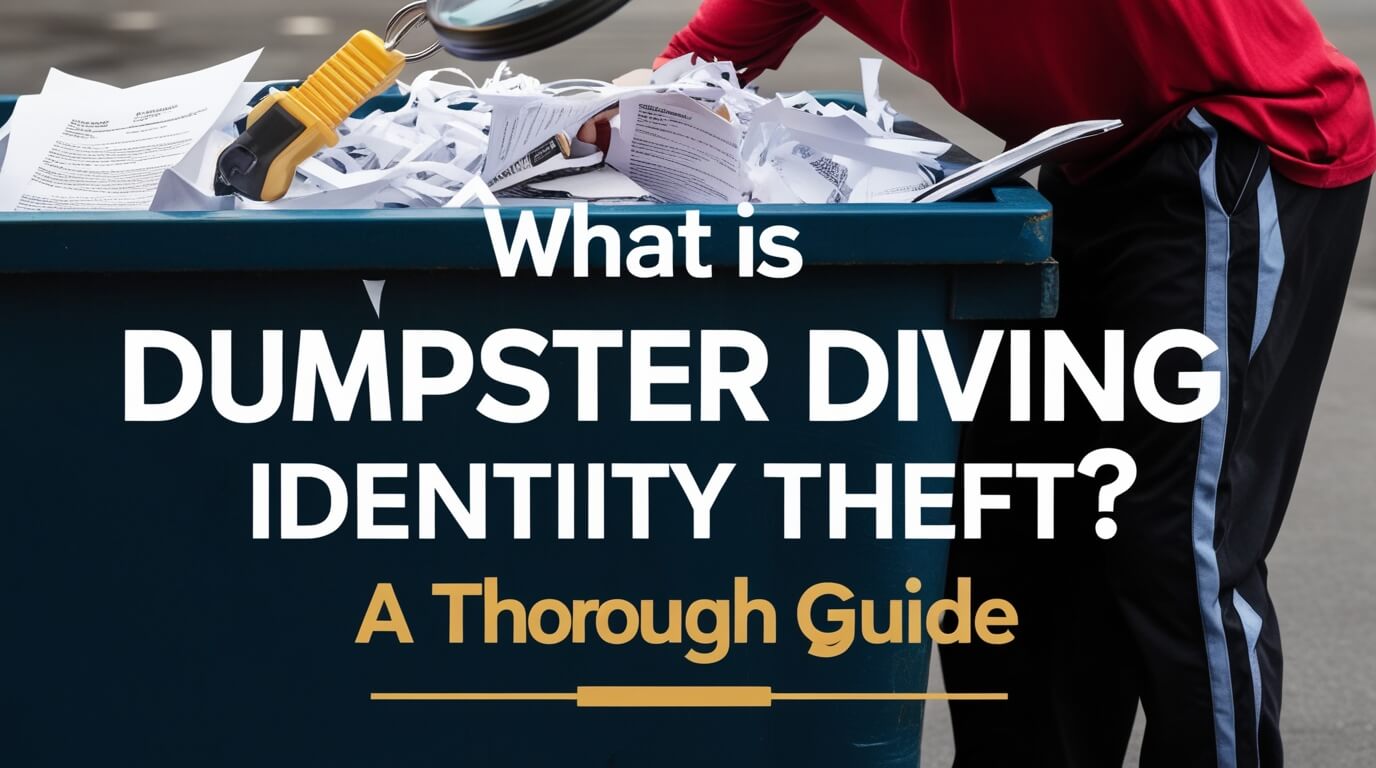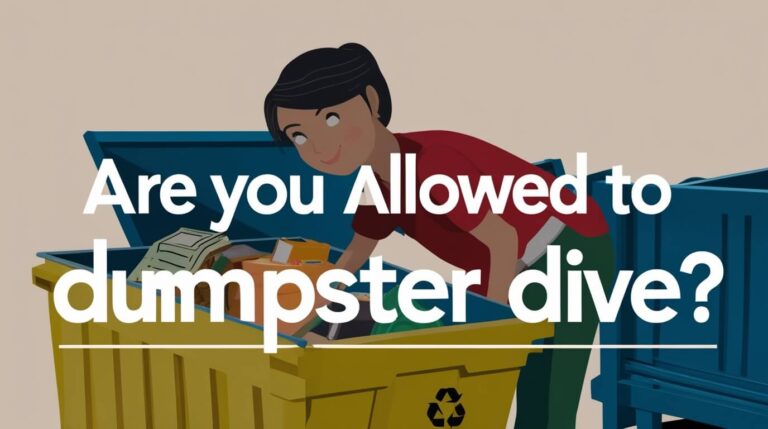
In today’s digital age, we often think of identity theft as a purely online crime – hackers stealing data through breached servers or phishing scams. However, there’s an old-school yet still prevalent method of identity fraud that doesn’t involve any computers at all: dumpster diving.
While it may seem like an antiquated tactic, dumpster diving identity theft remains a real and devastating threat to individuals and businesses alike. But what exactly is it?
Dumpster diving identity theft is when criminals rummage through trash bins or dumpsters to find sensitive documents containing personal and financial information like names, addresses, social security numbers, bank statements, and more. They then use this stolen data to commit fraud – opening accounts, making purchases, draining funds, and more – all under the victim’s identity.
This comprehensive guide will cover the ins and outs of dumpster diving identity theft. We’ll explore what kind of information thieves seek, how they use it for criminal gain, real-world examples and statistics, and most crucially – steps you can take to prevent yourself from being targeted.
What is Dumpster Diving Identity Theft?
At its core, dumpster diving identity theft is a remarkably low-tech yet effective form of fraud. It involves criminals physically sifting through trash bins, dumpsters, recycling containers and other refuse areas to find discarded documents containing sensitive personal and financial data.
The types of information dumpster diving identity thieves aim to steal include:
- Names, addresses, and phone numbers
- Social Security numbers
- Birth dates
- Financial account numbers (bank accounts, credit/debit cards)
- Passwords and PINs
- Employment information
- Medical/health records
- Signatures
With enough of these details in hand, criminals can assume someone’s identity and wreak havoc through various fraudulent schemes like opening new credit accounts, applying for loans, making unauthorized purchases, filing false tax returns to claim refunds, and more.
While it may seem bizarre that people would dig through trash for this information in the 21st century, the unfortunate reality is that dumpster diving remains a common and lucrative tactic for identity thieves. That’s because so much of our personal paper trails – from bills and statements to pre-approved offers – still contain valuable data gold mines if improperly discarded.
Why Dumpster Diving Identity Theft Persists
Despite the rise of digital identity threats like phishing, data breaches, and malware, good old-fashioned dumpster diving is still a go-to technique used by identity fraud rings. There are a few key reasons why:
- Prevalence of Discarded Personal Data While many transactions and communications have gone paperless, most households and businesses still produce volumes of paper documents and mail containing sensitive personal data like names, addresses, account numbers, and more. If not properly disposed of, this discarded paper trail provides easy pickings for dumpster divers.
- Easy Access Unlike hacking or phishing which requires some technical skills, dumpster diving is an extremely low barrier to entry. Trash bins and dumpsters – whether residential or commercial – are often easily accessible to anyone passing by. Little effort is required beyond physically sifting through the contents.
- Low Risk In most areas, dumpster diving itself is not illegal as long as the dumpster or trash bin is not located on private property. The lack of strong legal deterrents combined with the ability to lurk in relative anonymity makes it an enticing, low-risk option for identity thieves.
- High-Profit Potential While rudimentary, a single dumpster-diving haul of discarded documents can yield enough personal data to fuel countless incidents of identity fraud against multiple victims. With low risk but high potential profits, it’s no wonder the practice persists.
The prevalence of dumpster diving as an identity theft vector is highlighted by some sobering statistics from studies and reports:
- A shocking 88% of identity theft cases involve dumpster diving according to some estimates
- Over 4 million tons of unshredded, sensitive documents from American households end up in landfills annually
- Identity fraud losses totaled nearly $25 billion in the U.S. in 2021 alone
- Reports of identity theft increased by over 85% between 2020 and 2022
Clearly, despite advances in cybersecurity, dumpster diving represents a persistent and growing physical threat vector that enables large-scale identity crimes. But just what are some of the tactics criminals use with stolen dumpster-dove data?
Common Types of Dumpster Diving Identity Fraud
Once dumpster divers have their hands on key personal and financial details like names, dates of birth, social security numbers, and account information, they can engage in a variety of criminal activities under the guise of the victim’s identity. Some of the most common and damaging include:
Financial Fraud
- Opening new credit card accounts and running up large unpaid balances
- Applying for loans (personal, auto, mortgage, etc.) in the victim’s name
- Making fraudulent purchases and draining funds from existing bank accounts
- Taking out lines of credit or increasing existing credit limits to spend lavishly
- Using stolen identities to add authorized users to existing credit accounts
Employment Fraud
Criminals use stolen personal information to apply for jobs under a victim’s identity. This allows them to illegally gain employment while the actual victim’s identity is on the hook for financial liabilities, background checks and any crimes committed on the job.
Tax Fraud
Thieves can use a stolen identity to file fraudulent tax returns on behalf of victims to claim tax refunds and deductions they aren’t entitled to. They may also use a victim’s identity to obtain employment and leave the victim responsible for unpaid taxes on those illegal wages.
Government Benefits Fraud
Personal data stolen from dumpster diving can be used to illegally claim government benefits like welfare, social security, medicare, or unemployment through identity fraud.
Creating Fake Identity Documents
Names, dates of birth, social security numbers, and other elements obtained through dumpster diving allow criminals to manufacture fake IDs, driver’s licenses, and other fraudulent identity documents for criminal enterprises.
Data Trading on the Dark Web
Harvested personal data from dumpsters is commonly bought and sold on dark web black markets, allowing identity fraud rings to further exploit victims while turning a profit.
As you can see, the potential criminal uses of dumpster-dived personal information are wide-ranging and extremely damaging to victims. Basic sensitive details when used maliciously can unleash absolute financial chaos and destroy a victim’s creditworthiness, provoke criminal liabilities, and lead to years of headaches trying to restore one’s good name and credit standing.
How to Prevent Becoming a Dumpster Diving Victim
Fortunately, there are some simple yet effective steps you can take to dramatically reduce the risks of dumpster diving identity theft:
For Individuals & Households
- Invest in a quality shredder and shred ALL sensitive documents before disposal – never throw bank statements, bills, pre-approved offers, or anything with your personal information directly into the trash/recycling unshredded
- Opt out of pre-screened offers of credit and insurance by mail which contain accessible personal data
- Thoroughly wipe or destroy hard drives, smartphones, and digital storage before disposing of old electronics that may contain personal info
- Be very cautious about what you place in curbside trash/recycling bins accessible to anyone on the street – shred first!
- Monitor financial accounts regularly for any suspicious unauthorized activity
For Businesses
- Implement robust document and data disposal policies with clear protocols for shredding, destruction, or wiping of sensitive information
- Use lockable secure document disposal bins for sensitive paperwork rather than standard trash bins
- Provide comprehensive training to ensure all employees understand proper handling and destruction protocols for personal data
- Thoroughly vet any third-party document disposal vendors and ensure they adhere to strict security standards
- Never leave trash bins or dumpsters containing sensitive business information in areas accessible to the public
Other Tips for Identity Protection
- Consider utilizing an identity theft monitoring and recovery service that can detect misuse of your information
- Be extremely cautious about sharing personal details like birthdate or social security number unless required
- Use strong, unique passwords for all important accounts and update them regularly
- Stay up-to-date on the latest identity theft tactics and scams reported in your area
While dumpster diving is a decidedly low-tech issue, it enables devastatingly high-impact identity crimes that can take months or years for victims to fully recover from. But taking basic precautions like shredding sensitive documents, opting out of junk mail offers, and being vigilant about the physical security of personal information can go a long way in prevention.
In today’s world of sophisticated cyber threats, it’s easy to overlook the dangers of such an antiquated tactic as dumpster diving. However, the criminal exploitation of carelessly discarded personal data remains a prevalent and costly crime that no individual or business can afford to ignore.
Understanding dumpster diving identity theft helps you identify and mitigate risk. Thieves seek personal information to commit fraud, so properly destroy or secure documents to avoid becoming a victim.
So stay vigilant, make shredding a habit, and don’t let your sensitive data become a treasure trove for unscrupulous dumpster-diving thieves. A little prevention and caution regarding physical data security can save you immense headaches and financial fallout in the long run.
Conclusion
Dumpster diving identity theft represents a pervasive yet often overlooked physical threat vector enabling large-scale identity crimes. Despite its old-school simplicity, rummaging through trash for discarded personal data continues to be a go-to method for fraudsters looking to assume victims’ identities for financial gain.
The key to avoiding this low-tech, high-impact crime is two-fold: understanding what dumpster divers are after and the types of fraud they perpetrate, and most importantly, taking proactive preventative steps to properly dispose of and secure all documents containing sensitive personal and financial information.
By shredding statements, bills, and documents before disposal, opting out of junk mail credit offers, monitoring accounts regularly, and training employees on data security protocols, individuals and businesses alike can mitigate their exposure and make dumpster diving identity theft a fruitless endeavor.
In an age of increasingly sophisticated digital security hurdles, criminals will continue gravitating towards perceived “easy” analog ID theft methods like dumpster diving. Don’t let your discarded paperwork become the next payload fueling identity crimes – stay vigilant in protecting your data both physically and digitally. A little prevention truly does go a long way.






